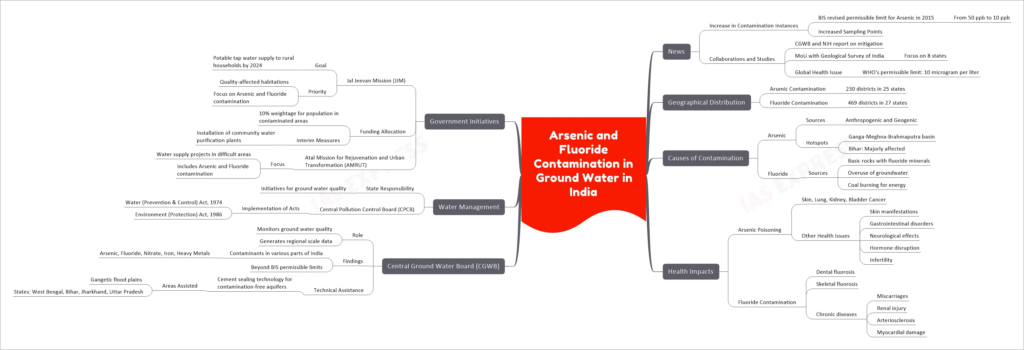Arsenic and Fluoride Contamination in Ground Water in India

Recent Updates
- Increase in Contamination Instances: BIS revised the permissible limit for Arsenic in 2015 from 50 ppb to 10 ppb, and increased sampling points.
- Collaborations and Studies: CGWB and National Institute of Hydrology (NIH) report on mitigation, Memorandum of Understanding (MoU) with Geological Survey of India focusing on 8 states, and recognition of the issue as a global health issue with World Health Organization’s (WHO) permissible limit being 10 microgram per liter.
Geographical Distribution
- Arsenic Contamination: Found in 230 districts across 25 states.
- Fluoride Contamination: Found in 469 districts across 27 states.
Causes of Contamination
- Arsenic: Sources include both anthropogenic and geogenic, with hotspots in the Ganga-Meghna-Brahmaputra basin and Bihar being majorly affected.
- Fluoride: Sources include basic rocks with fluoride minerals, overuse of groundwater, and coal burning for energy.
Health Impacts
- Arsenic Poisoning: Can lead to Skin, Lung, Kidney, Bladder Cancer, and other health issues such as skin manifestations, gastrointestinal disorders, neurological effects, hormone disruption, and infertility.
- Fluoride Contamination: Can lead to Dental fluorosis, Skeletal fluorosis, and chronic diseases such as miscarriages, renal injury, arteriosclerosis, and myocardial damage.
Central Ground Water Board (CGWB)
- Role: Monitors ground water quality and generates regional scale data.
- Findings: Identified contaminants in various parts of India including Arsenic, Fluoride, Nitrate, Iron, and Heavy Metals, which are beyond the Bureau of Indian Standards (BIS) permissible limits.
- Technical Assistance: Provided cement sealing technology for contamination-free aquifers in areas such as the Gangetic flood plains and states like West Bengal, Bihar, Jharkhand, and Uttar Pradesh.
- State Responsibility: States are responsible for initiatives for ground water quality.
- Central Pollution Control Board (CPCB): Implements the Water (Prevention & Control) Act, 1974 and the Environment (Protection) Act, 1986.
Government Initiatives
- Jal Jeevan Mission (JJM): Aims to provide potable tap water supply to rural households by 2024, with a focus on quality-affected habitations and Arsenic and Fluoride contamination.
- Funding Allocation: 10% weightage is given for population in contaminated areas, with interim measures including the installation of community water purification plants.
- Atal Mission for Rejuvenation and Urban Transformation (AMRUT): Focuses on water supply projects in difficult areas, including those with Arsenic and Fluoride contamination.

